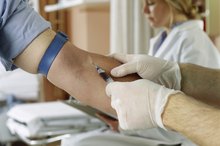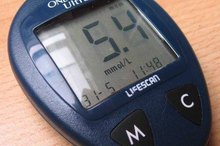How Accurate Is the Finger Prick Cholesterol Test?
The National Cholesterol Education Program, established in 1985, stresses the importance of getting your cholesterol checked at least every five years. Monitoring your cholesterol levels helps you to understand and control your risk for heart disease. Public health fairs offer cholesterol screening tests that use a finger prick cholesterol test, providing a result nearly instantaneously 3. You can buy these types of tests for use at home. Although they can provide accurate results when performed correctly, it's important to understand that these test only detect the "total" cholesterol level, which does not provide a complete picture of your risk for heart disease.
Types of Cholesterol
Cholesterol is a waxy fat-like substance produced by the cells in your liver. Scientists classify it as a lipid because it cannot mix with water, which means it cannot travel in the blood to reach your cells. The liver cells also produce specialized proteins known as lipoproteins that consist of protein on the outside with triglycerides and fat on the inside, which binds to cholesterol and carries it through the bloodstream to deliver it to cells. Low-density lipoprotein, known as LDL, carries the majority of cholesterol from the liver to the cells. High-density lipoprotein, or HDL, picks up excess cholesterol from the tissues and blood vessels, returning it back to the liver where it gets used to create bile acids.Unlike the finger prick test, an accurate cholesterol profile tells you the amount of each type of cholesterol.
- Cholesterol is a waxy fat-like substance produced by the cells in your liver.
- The liver cells also produce specialized proteins known as lipoproteins that consist of protein on the outside with triglycerides and fat on the inside, which binds to cholesterol and carries it through the bloodstream to deliver it to cells.
Finger Prick Screening
The Difference Between Nonfasting & Fasting Cholesterol Tests
Learn More
Finger prick screening tests do serve an important purpose; they can warn you of potential health problems. The finger prick test is easy to perform because it only takes a small prick of your finger to get a drop of blood. When getting the drop of blood, however, do not squeeze or milk your finger, as this could cause an inaccurate result, according to the "Harvard Medical School Family Health Guide." This test reports just one result: total cholesterol. If your result is high, over 200 mg/dL, you have an increased risk of heart disease and should seek further medical testing and advice from your doctor. A result of under 200 mg/dL does not necessarily mean you are completely healthy. Without knowing your HDL and LDL cholesterol number, you cannot get an accurate assessment of your heart disease risk.
- Finger prick screening tests do serve an important purpose; they can warn you of potential health problems.
- A result of under 200 mg/dL does not necessarily mean you are completely healthy.
HDL and LDL
To determine the level of HDL and LDL in your blood, you need to get a complete lipid profile test done at your doctor’s office and laboratory. In addition, you need to fast for at least 9 to 12 hours prior to giving the blood sample to get an accurate LDL cholesterol result. The American Heart Association and doctors consider your LDL cholesterol a more accurate gauge of heart disease risk than total cholesterol 2. Your total cholesterol, as tested by the finger prick test, may be 185 mg/dL, which falls into the desirable range, but if your LDL cholesterol is 160 mg/dL and your HDL is 25 mg/dL, you are at risk for heart disease. For the lowest risk of heart disease, your LDL cholesterol should remain under 100 mg/dL and your HDL cholesterol should be at least 40 mg/dL for men and 50 mg/dL for women.
- To determine the level of HDL and LDL in your blood, you need to get a complete lipid profile test done at your doctor’s office and laboratory.
- Your total cholesterol, as tested by the finger prick test, may be 185 mg/dL, which falls into the desirable range, but if your LDL cholesterol is 160 mg/dL and your HDL is 25 mg/dL, you are at risk for heart disease.
Result Interpretation
The Effects of Eating Before Cholesterol Test
Learn More
Interpreting your cholesterol results and determining your heart disease risk is not easy. To provide you with an accurate risk assessment, your doctor takes into account the other heart disease risk factors you may have. For example, a person with no other risks for heart disease may not increase his risk with an LDL cholesterol level of 150 mg/dL, but this level would be considered at high risk for someone else with two or more heart disease risk factors. For this reason, you should not depend on only the result of a finger prick cholesterol test, especially when performed at home.
- Interpreting your cholesterol results and determining your heart disease risk is not easy.
- To provide you with an accurate risk assessment, your doctor takes into account the other heart disease risk factors you may have.
Related Articles
References
- Harvard Medical School Family Health Guide: Cholesterol Testing at Home – It May be Faster But Is It Better?; April 2003
- American Heart Association: What Your Cholesterol Levels Mean; June 2011
- Lab Tests Online: LDL Cholesterol Test; March 2011
- American Heart Association. What your cholesterol levels mean. Updated April 30, 2017.
- National Heart, Lung, and Blood Institute. High blood cholesterol: also known as hypercholesterolemia.
Writer Bio
Stephanie Chandler is a freelance writer whose master's degree in biomedical science and over 15 years experience in the scientific and pharmaceutical professions provide her with the knowledge to contribute to health topics. Chandler has been writing for corporations and small businesses since 1991. In addition to writing scientific papers and procedures, her articles are published on Overstock.com and other websites.









